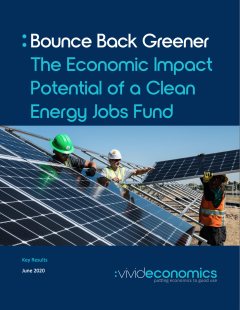
A Clean Energy Jobs Fund (CEJF)—building on the established green bank model the has already been demonstrated at the state and local level in the US and at the national level in countries as diverse as the United Kingdom, Australia, India, and South Africa—can accelerate US public and private investment and fight climate change. Investment in the CEJF through a US$35 billion federal capitalisation has the potential to unlock substantially greater levels of investment: alongside private finance to mobilise billions of dollars in additional investment and catalyse longer-term changes by accelerating the commercial viability and private financing of climate investments.
In addition to supporting climate action, climate banks like the CEJF also support economic growth and jobs as well as a green recovery from COVID-19. For example, Michigan Saves, Michigan’s non-profit climate bank, estimates that every dollar it holds in reserves translates into at least US$30 of private investment that flows back into the state’s economy and that, by investing US$220 million in energy improvements between 2010 and 2019, the climate bank supported approximately 4,400 full-time jobs.
This report summarises key messages from an analysis of the job creation impact potential of the CEJF. To assess the economic impact from the CEJF at the national level, this analysis applies a three-step modelling process to consider the total new investment that can be driven by the CEJF, how that financing might be deployed within the CEJF’s target sectors, and how investments in those sectors translate to new jobs. Future analysis during 2020 will expand on this assessment through state-specific analysis to quantify the climate mitigation, economic growth, and job creation benefits from the CEJF in more detail.
